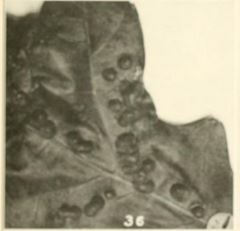Polystepha pilulae
Cincticornia pilulae
This species appears to be one of the commonest representatives of the genus. The gall is by no means rare on various species of oak in the vicinity of Albany and in other parts of the country. It is presumable that all of the citations given above relate to this form, though we have reared Cynipids from galls supposed to be made by Cincticornia on several occasions. It would not be surprising if the work of two very dissimilar insects had been confounded occasionally. The late Dr M. T. Thompson of Clark University records the appearance of the young gall at Worcester, Mass., the second week in June, while Professor Beutenmueller states that in the vicinity of New York City it begins to develop in May and becomes full size by August or September. At first it is blister- like, yellow or pale brown and surrounded by a light-green ring. The full-grown gall varies greatly in size, ranging from about 3 to 6 or 7 mm in diameter and presents a characteristic reticulated appearance. The insect winters in the gall, the larvae escape and form silk-lined cells among leaves or in the soil prior to trans- formation. The late Doctor Thompson records having taken this gall on Quercus ilicifolia, Q. rubra, Q. coccinea, Q. stellata and Q. palustris. It also occurs on Q. falcata, Q. velutina and Q. nigra. Professor Beutenmueller states that it is found on various species belonging to the red oak group. Galls of this species were received from Riverdale, Md. through Dr W. L. McAtee accompanied by the statement that flocks of sparrows were observed opening the galls and eating the larvae.
There is in the Museum of Comparative Zoology at Cambridge, Mass., a gall labeled Cecidomyia palustris O. S. The deformity described by him (Ent. Soc. Phil. Proa, 1 1252 and 4:359) is most probably the work of a Cincticornia and may be only a modified form of C. pilulae Walsh.
The adult of what may have been this species was briefly characterized by Dr A. S. Packard in the 5th Report of the U. S. Entomological Commission. The characters given are insufficient for the recognition of the species and it is possible that Doctor Packard was misled and characterized an inquiline or some form issuing from other material. We were fortunate in rearing a large series of adults in the spring of 1909. Midges of this species were obtained in numbers by the late Dr M. T. Thompson of Worcester, Mass., from material collected in that vicinity. It was taken by Prof. C. W. Johnson May 19, 1901 at Clementon, N. J., April 26, 1896 in Delaware county, Pa., and was reared from galls on Quercus nigra and Q. rubra taken at Washington, D. C, in March and April 1896 by the bureau of entomology. These specimens, while presenting some minor variations among them- selves, are probably all referable to one species. This midge appears to be widely distributed, having been recorded, in addition to the localities given above, from Mississippi, Indiana, Illinois and Rhode Island.
Gall. Reddish brown, coarsely reticulate, thick walled, irregularly subglobose, 3 to 4 mm in diameter, somewhat depressed or fused to form lobulate masses 1 cm or more in length. The galls may occur scatteringly on the leaves or be present in large numbers, there being from 1 to 4 or 5 up to possibly 75 on a leaf. On badly infested leaves the galls may be confluent, and occasionally a considerable number adhere to form an almost continuous mass on one or both sides of the midvein. The young galls are fleshy while the old ones are very hard and woody. Normally but one larva occurs in the typical gall, though three or four are frequently present in a confluent mass.
”- EP Felt: (1915) 31st Report of the State Entomologist on Injurious and Other Insects of the State of New York©
Reference: https://www.biodiversitylibrary.org/page/36619989#page/552/mode/1up






